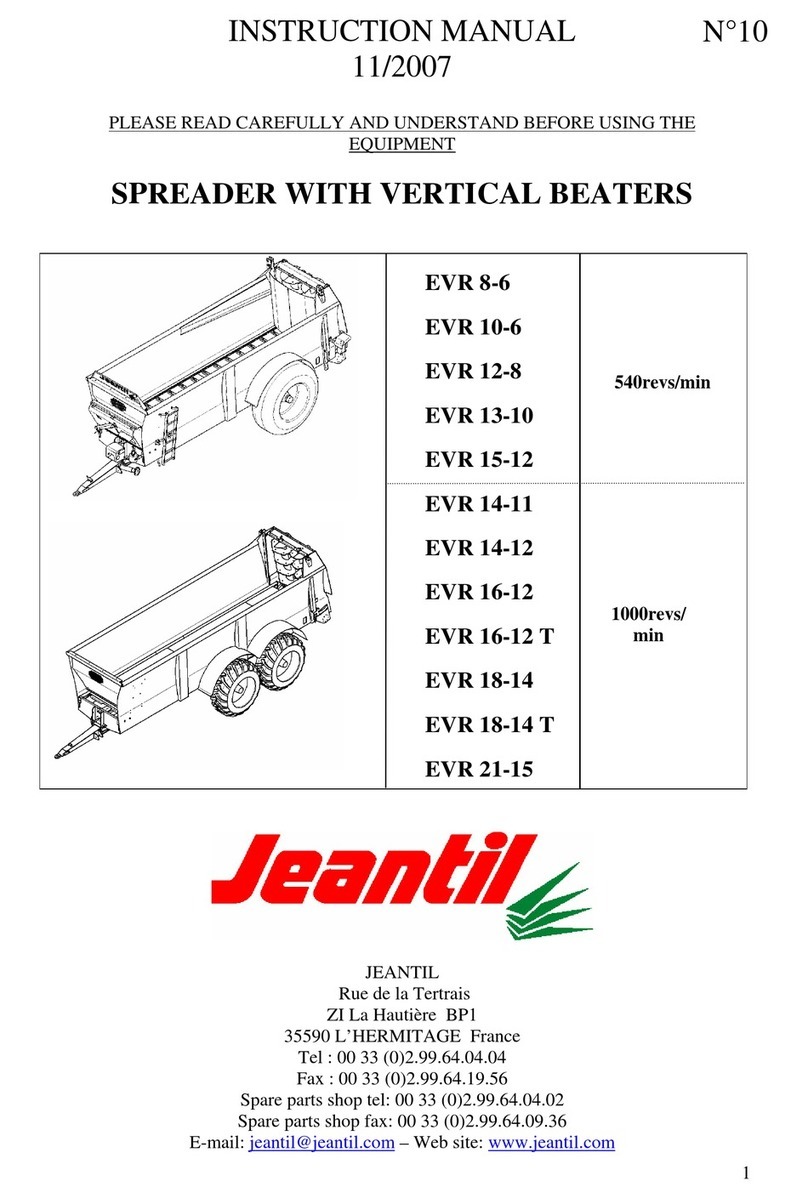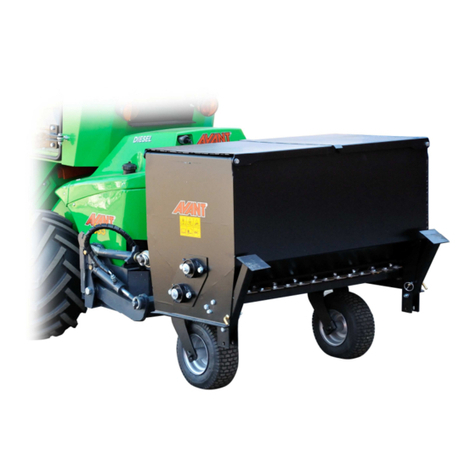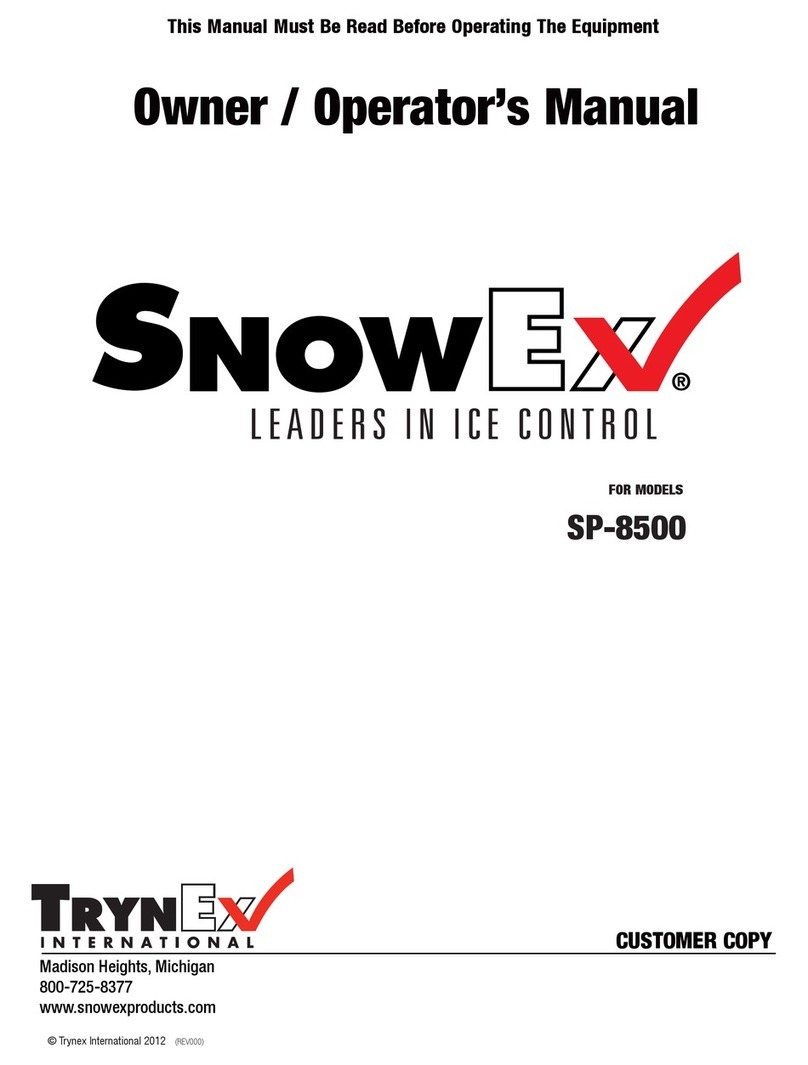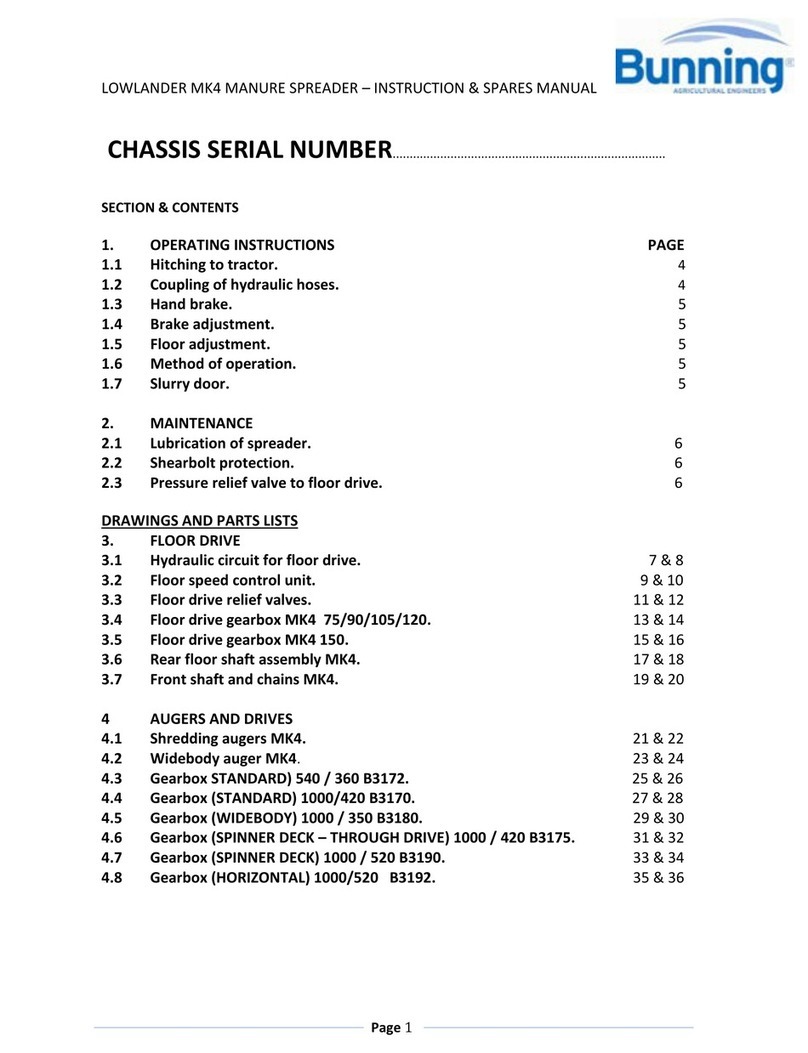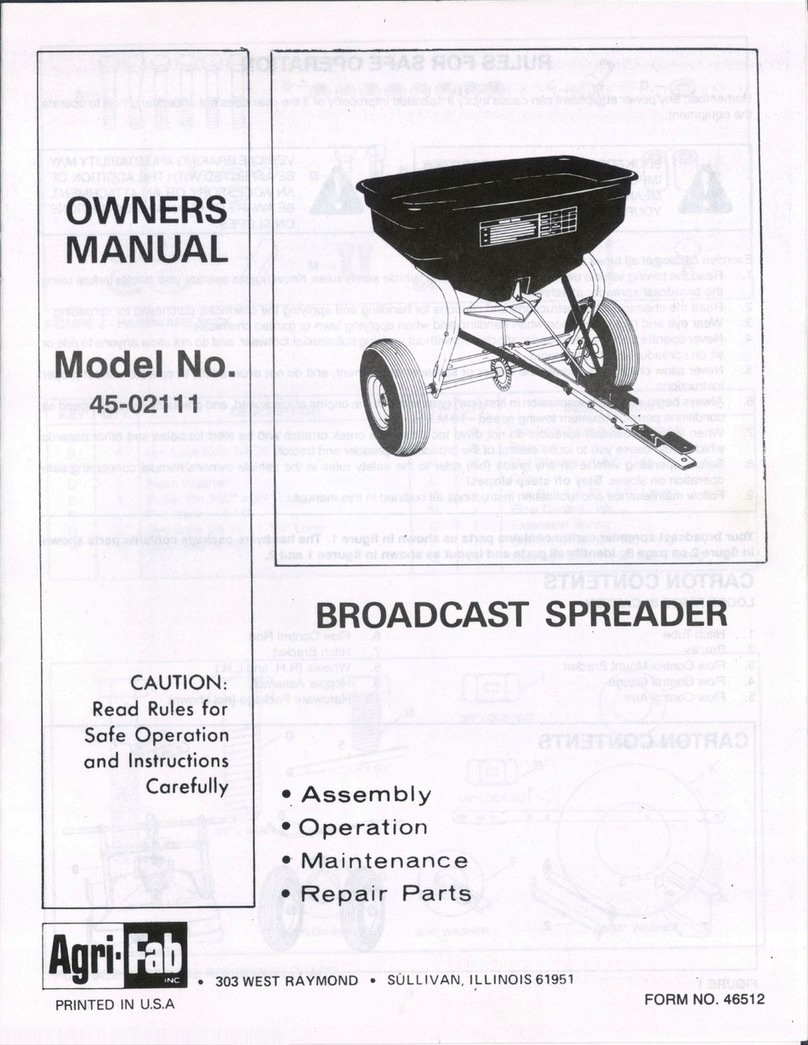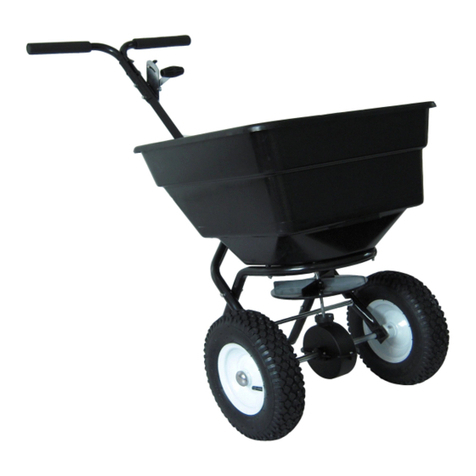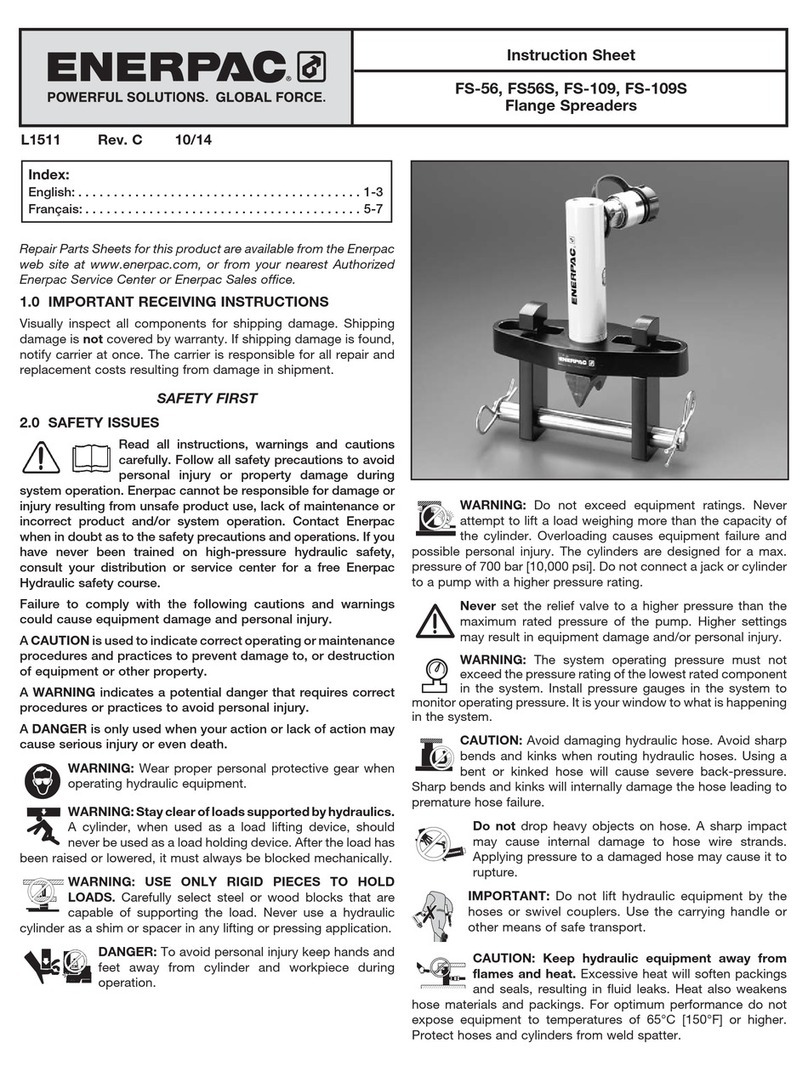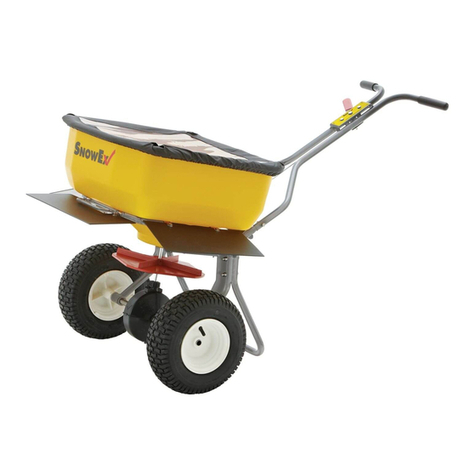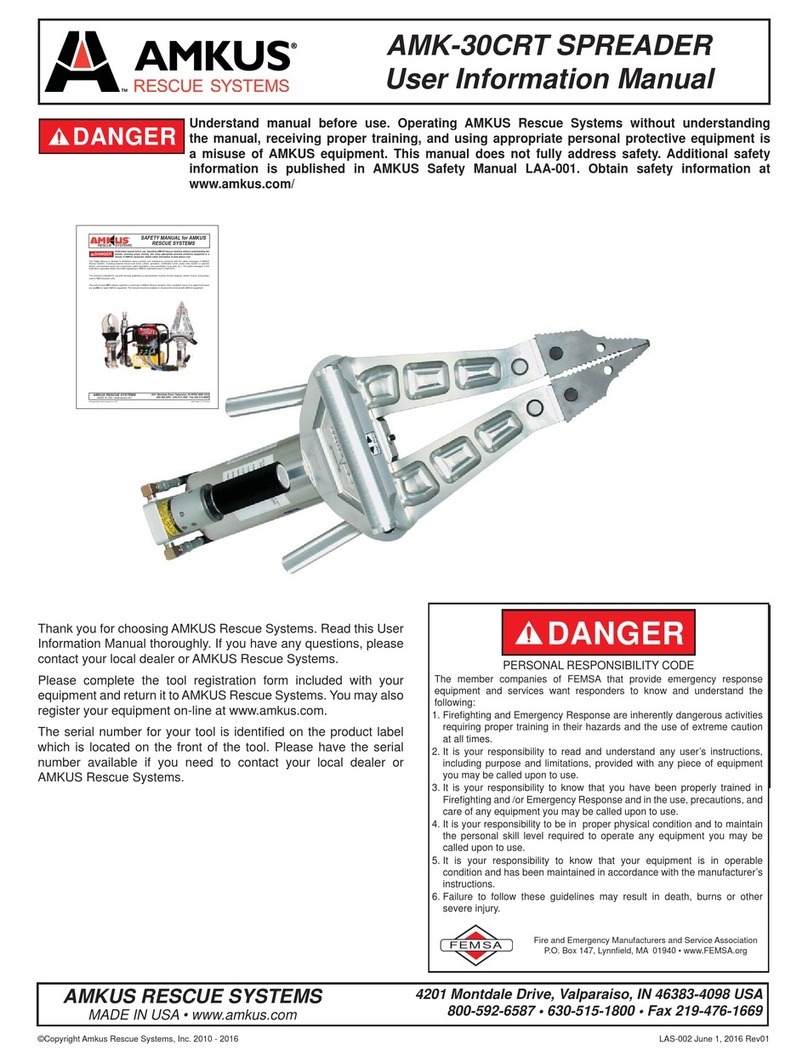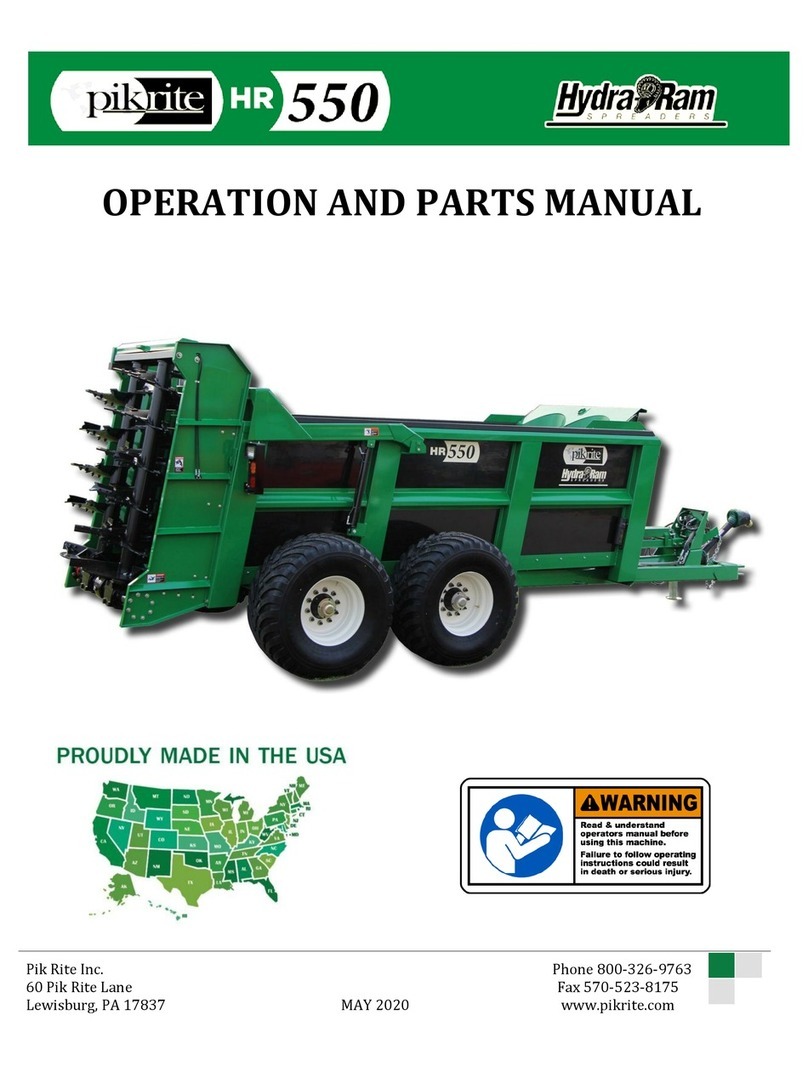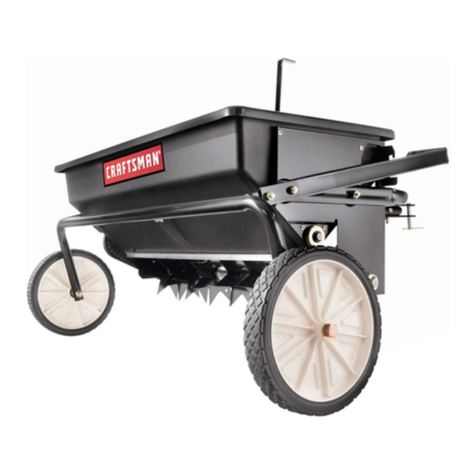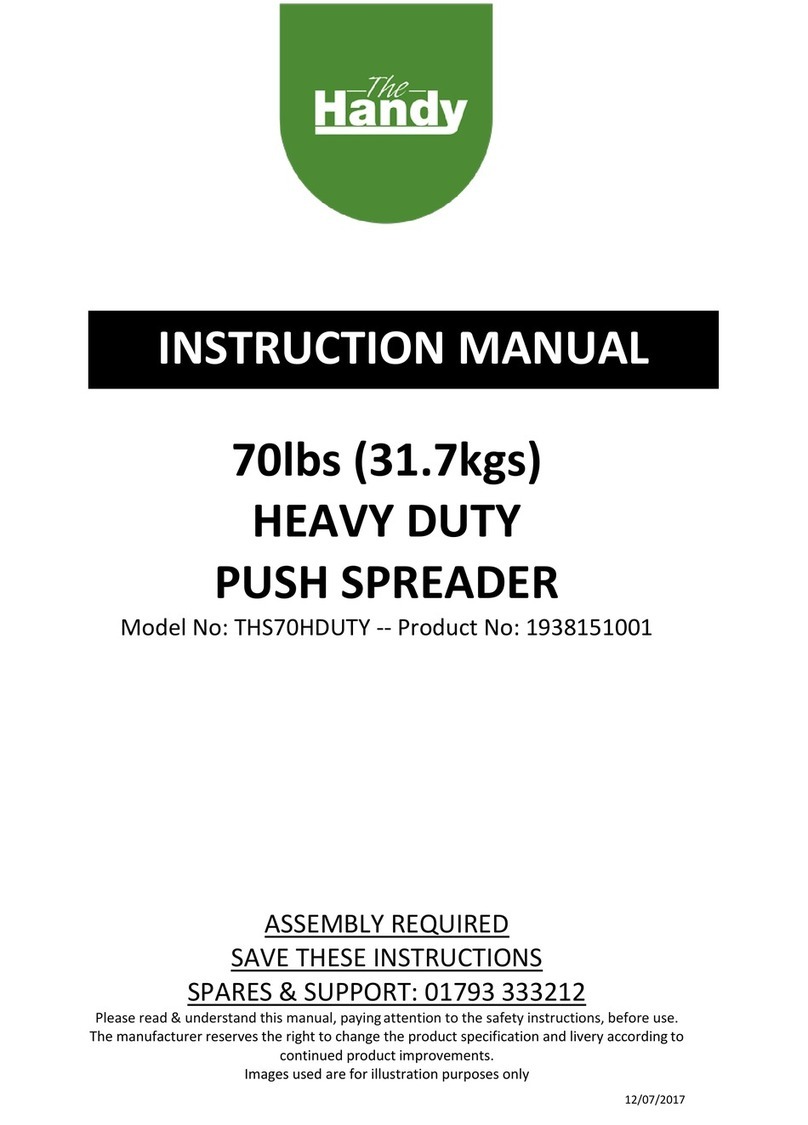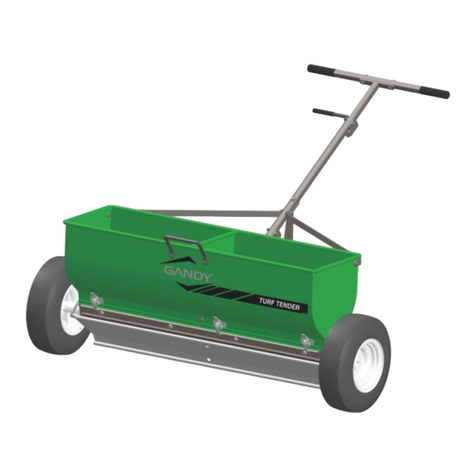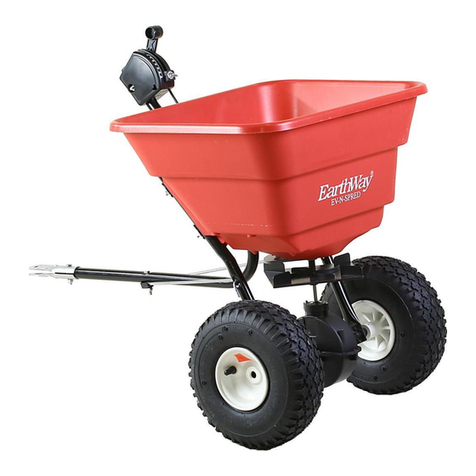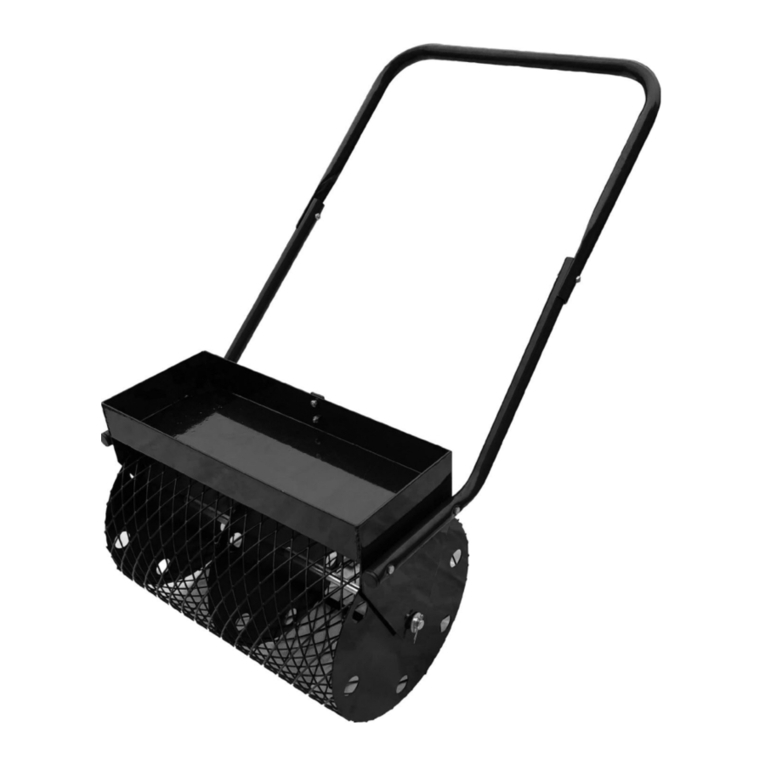JEANTIL EPR Series User manual

1
INSTRUCTION MANUAL
07/2009
PLEASE READ CAREFULLY AND UNDERSTAND BEFORE USING THE
EQUIPMENT
MANURE SPREADER EPR
1000 revs/min
EPR 23-16 Bogie
EPR 23-18 Axle
EPR 27-18 Axle
EPR 27-20 Axle
JEANTIL
Rue de la Tertrais
ZI La Hautière BP1
35590 L’HERMITAGE France
Tel: 00 33 (0)2.99.64.04.04
Fax: 00 33 (0)2.99.64.19.56
Spare parts shop tel: 00 33 (0)2.99.64.04.02
Spare parts shop fax: 00 33 (0)2.99.64.09.36
N° 2

2
E-mail: jeantil@jeantil.com – Web site: www.jeantil.com
1. Aim of the Instruction Manual
1). General
The manual concerns all users of the equipment and any person responsible for
assembling, installing, operating, adjusting, servicing, repairing or transporting
the equipment and its accessories.
The manual contains practical information for the correct and safe operation,
handling, adjusting and maintenance of your equipment.
Read carefully and ensure you understand the content before using the
equipment. Comply with the instructions and the safety-related advice.
2). Warning symbols
This warning symbol identifies important advice that must be followed for
your safety. When you see this symbol, be aware that there is a potential risk of injury;
read carefully the advice that follows it and inform other users.
3). Keeping the manual
Always keep this manual within easy reach or at your place of work (or
operating site).
Pass it on to any other user, including if you lend or sell the equipment.
4). Contact details (customer service)
JEANTIL
Rue de la Tertrais
ZI La Hautière BP1
35590 L’HERMITAGE France
Tel: 00 33 (0)2.99.64.04.04
Fax: 00 33 (0)2.99.64.19.56
Spare parts shop tel: 00 33 (0)2.99.64.04.02
Spare parts shop fax: 00 33 (0)2.99.64.09.36
E-mail: jeantil@jeantil.com – Website: www.jeantil.com

3
5). Statement of compliance with the European ‘Equipment’ directive
N°98/37/CE.
And to any relevant transposition regulations
The manufacturer: JEANTIL
Rue de la Tertrais
ZI de La Hautière
35590 L’HERMITAGE – France
DECLARES THAT THE EQUIPMENT manufactured by JEANTIL as designated
below:
Spreader, bogie EPR 23-16
Spreader, 2 axles EPR 23-18 EPR 27-18
Spreader, 3 axles EPR 27-20
SERIAL N°: ……………
COMPLIES WITH:
1- Labour regulations
2- The revised European equipment directive N°98/37/EC
3- Revised EMC directive (electromagnetic compatibility) N° 89/336 EC
4- Specific safety standards: NF / EN 690 (Spreaders)
5- General safety standards: NF/EN/ISO 12100-1
NF/EN/ISO 12100-2
NF/EN 294
NF/EN 349
NF U 02-001-ISO 4254/1
NF EN 1553
NF EN 811
6- Highway code
SIGNED AT L’HERMITAGE, ON ………/………/……………
NAME OF SIGNATORY: JEANTIL Philippe
SIGNATURES :
01 12 2008

4
2. Contents
1. Aim of the instruction manual
1). General Erreur ! Signet non défini.
2). Warning symbols Erreur ! Signet non défini.
3). Keeping the manual Erreur ! Signet non défini.
4). Contact details (customer service) 2
5). Statement of compliance with the European ‘equipment’ directive 3
2. Contents
3. Equipment identification
4. Standard operating conditions
1). Applications of the equipment 7
2). Operator qualification 7
3). Defining the operating stations 7
4). Environmental conditions 7
5). Manufacturer’s and user’s responsibilities 7
5. Technical characteristics
1). Dimensions 8
2). Stowing diagram 9
6. General safety rules
1). General 10
2). Warning / Pictograms 11
3). Coupling 14
4). Failure (or jamming of the equipment) 14
5). PTO / Drive shaft 15
6). Maintenance and repair 15
6.a. General 15
6.b. Welding operations 16
6.c. Servicing the tyres 16
6.d. Electric servicing 16
6.e. Hydraulic servicing 16
6.f. Repair 16
7. Environmental protection
8. Fitting and installation
1). Coupling 17
2). Drive shaft 17
2.a. Primary drive shaft 17
2.b. Secondary drive shaft 18
3). Hydraulics 18
4). Electricity 19

5
9. Adjustments and maintenance
1). Greasing 19
2). Oil change 20
3). Various advice 21
4). Chains 21
5). Wheels 21
6). Hydraulic hoses 22
7). Speed of moving floor’s hydraulic motor 22
8). Torque limiter 23
8.a. On secondary transmission. 23
8.b. Adjustments (re-calibration) 23
9). Hydraulic safety valves 25
10). Door safety valve 25
11). Short period uses 25
10. Start-up and operation
1). Important information 25
2). Loading 26
3). Spreading 26
4). Quantity to spread per hectare 27
11. Additional equipment information
1). Closed hydraulic circuit 27
2). Independent hydraulic power unit 28
3). Spreader meter 28
4). Rear door for thick slurry 28
5). Grain and silage extension 29
6). Load transfer 29
7). Hydraulic stand 30
12. Cleaning
13. List of technical documents
14. Possible incidents and solutions

6
3. Equipment identification
Type
N° de
série
Année de
construction
P.T.A.C.
Réceptionné
Masses
maximales
admissibles
Anneau
Essieu 1
Essieu 2
kg
kg
kg
kg
20
kg
Essieu 3
35590 L'HERMITAGE - FRANCE
Ref: 892 770
Manufacturer’s plate to EC standards.
Never remove the manufacturer’s plate and the EC marking fixed
to the equipment.

7
4. Standard operating conditions
1). Applications of the equipment.
This equipment is intended exclusively for general agricultural purposes i.e.:
transporting and spreading manure, transporting silage.
Any other use falls outside normal usage and is therefore forbidden.
For any other use, please contact the manufacturer.
2). Operator qualification.
The equipment must only be used, maintained and repaired by trained
operators.
Before using your equipment, acquaint yourself with all controls and their
correct operation.
All users, prior to using the spreader, must have carefully read this Manual,
have understood it and applied all the safety instructions. Once working, it will be too
late to do this.
3). Defining the operating stations.
1. The only operating station for the equipment is the tractor’s driving station.
2. Never leave the driving station when the engine of the tractor and the equipment are
operating.
3. To access the operating station, use the access devices provided by the manufacturer
(ladder, running board).
4). Environmental conditions.
1. Never approach or remain in the areas that are dangerous when the equipment is in
operation.
2. Adapt your speed and driving style to the lands, roads and tracks. Be cautious and
careful!
3. Do not operate vehicles on slopes (tilting backwards, forwards or on the side) when
there is a risk of tipping or overturning.
4. Do not start or brake abruptly.
5. Operate your equipment with sufficient light to ensure safety; use appropriate artificial
light if necessary (contact your dealer or mechanic).
5). Manufacturer’s and user’s responsibilities.
1. Follow all advice contained in this manual regarding levels of knowledge, installation
procedures, operation, adjustment, maintenance and repair.

8
2. Only use spare parts and accessories that comply with the manufacturer’s
recommendations.
3. Do not carry out any modifications yourself and do not allow others to modify your
equipment and its accessories (mechanical, electrical, hydraulic or pneumatic
characteristics) without requesting prior written approval from the manufacturer.
4. Failure to comply with these requirements may make the machinery dangerous. The
manufacturer disclaims any responsibility if damage or injury arises from such action.
5. Technical characteristics.
1). Dimensions.
EPR Spreader characteristics
TYPES EPR 23-16 EPR 23-18 EPR 27-18 EPR 27-20
Working load 16 T 18 T 18 T 20 T
Unladen weight (kg) ?kg ?kg ?kg ?kg
A: Internal length of body 5,70 m 5,70 m 6,70 m 6,70 m
B: Internal width of body 2,00 m / 2,3 m 2,00 m / 2,3 m 2,00 m / 2,3 m 2,00 m / 2,3 m
C: Height of body 1400 1400 1400 1400
D: Overall length 8724 8724 9724 9724
E: Overall height 4155 4155 4155 4155
F: Overall width 2770 2770 3070 3070
Epan 7
- 2 Horizontal beaters Ø650
- 2 Spreading discs Ø1100
●●●●
PTO 1000 revs/min ●●●●
Belt 4 chains Ø 16 ●●●●

9
Guillotine door ●●●●
Spring drawbar ●●●●
Hydraulic stand ●●●●
Load transfer ●●●●
Spreader meter ●●●●
1st side shutter ●●●●
Hydraulic power unit
- rate 45 l/min
(1000revs/min) ■■■■
2nd side shutter ■■■■
Forward proportional flow
with radar ■■■■
Weighing, 4 sensors ■■
Weighing, 6 sensors ■■
Following axle ■
Rear steering axle ■■■■
Front and rear steering
axle ■
Ball joint ring K80 ■■■■
Tele-pressure 2 axles ■■■
Tele-pressure 3 axles ■
●Standard
■Option
The equipment complies with safety standards. We reserve the right to change our equipment and
their characteristics at any time.
2). Stowing diagram.

10
6. General safety rules.
1). General.
1- Never forget that knowledge, awareness and caution are the best way to ensure your
safety.
2- Regulations and rules relating to accident prevention, health and safety at work, and
the operation of vehicles on the public highway must be observed at all times.
3- Chapter 4 (Standard operating conditions) of this Instruction Manual, contains basic
directives that must be followed for the sake of your safety.
4- Make sure that no person, animal or obstruction is located near the equipment before
it is set in motion and throughout its operation or any other manoeuvre.
5- Children must never be allowed near the equipment.
6- Never carry passengers on the equipment.
7- Do not step on the hoods or on any other parts of the equipment, except areas
provided for this purpose (ladder, platform, and means of access to the work
station).
8- Before carrying out any work on the equipment, ensure that it cannot be started up
accidentally.
9- All controls (ropes, cables, rods, hoses, etc.) must be positioned in the locations
provided for them so that they cannot accidentally initiate a manoeuvre likely to
cause an accident or damage.
10- Before use and after any adjustment or maintenance, ensure that all protective
devices are in position and in good condition, and that their latches are engaged.
11- Before use, check tightness of screws, nuts, connectors and wheels. Retighten if
required.
12- Do not wear loose clothing, long untidy hair and jewellery that might get caught in
the moving parts of the equipment.
13- Keep your hands, arms and feet well away from any moving parts, even those that
are slow-moving. Keep well away from moving parts.
14- If you detect any unusual noise or vibration, stop the equipment, and identify and
eliminate the cause of the incident before resuming work. Contact your dealer if
required.

11
2). Warning / Pictograms.
1. Warnings and pictograms placed on the equipment provide information about safety
measures to be taken, that will contribute to avoid accidents.
2. Make sure that these warnings and pictograms remain clean and legible. If they are
damaged, ask for new stickers from the manufacturer (or agent).
3. If repairs are carried out, check that the replacement parts carry the same stickers as
those that have been removed.
WARNING
Ref: 892 640
SAFETY AND OPERATING STICKER
CLEARLY placed IN FULL VIEW on the
front of all items of equipment, close to the
components used to connect the unit to the
tractor.

12
Stickers for use of equipment.
Ref: 892 652
Placed next to parts which
need greasing.
See diagram
Ref: 892 446
Placed on metallic casing of primary
drive shaft
Ref: 892 687
Placed on the right
and left sides, at
the back of the
s
p
reader
Ref: 892 703
EP with distributor
and rear cover
Ref: 892 651
Placed on the left side of
the drive shaft casing
Ref: 892 653
Placed at the
back of the
mudguards

13
Ref: 892 227
Placed on the front right and left sides of body
Ref: 892 453
Placed above right
and left tail lights
Ref: 892 230
Placed at the front of the spreader
Ref: 892 299
Placed on rear left, next to
the valve of rear door

14
3). Coupling.
1- See chapter 5, Technical characteristics, pages 8 and 9.
2- Hitching the machine to the tractor must only be carried out using the tractor’s rear
coupling points provided for this purpose.
3- Check the compatibility of the machine with the tractor (minimum engine power,
type of coupling, tractor PTO characteristics, etc.). Keep clear of the area between
the tractor and the machine until you have stopped the tractor’s engine and removed
the starter key.
4- Keep clear of the area between the tractor and the machine during any lifting
manoeuvre of the tractor.
5- When manoeuvring, select the lowest possible tractor gear ratio. When coupling,
attach the equipment’s electric control unit in the tractor cab, ensuring that it cannot
move during operations.
6- Once the equipment has been coupled up, the hitch must be locked. Check the
coupling is correctly locked and in good condition before any movement.
7- Check that the equipment’s coupling does not create either an overload or poor
weight distribution on the tractor that might compromise stability:
- Do not exceed the maximum allowed loading for the tractor and equipment
attachment points.
-Where necessary, fit ballast weights to the mounts provided for this purpose in
accordance with the tractor manufacturer’s recommendations.
Couple the equipment to a tractor whose linkage is equipped with lateral and vertical
locking devices.
8- To drive on roads, respect the coupling height specified in the instruction manual.
4). Failure (or jamming of the equipment).
1- Stop the machine.
2- Disengage the tractor PTO.
3- Wait until all the moving parts are completely at a halt.
4- Stop the tractor engine and remove the starter key or disconnect the battery (or the
electric connector).
5- Select the gear shift into neutral.
6- Engage the parking brake.

15
5). PTO (power take-off) / Drive shaft.
1- Read and learn the manufacturer’s instructions for the drive shaft.
2- Check that the PTO guards are in place and in a good condition. Replace them
immediately if damaged.
3- Adjust the length between the tractor and the machine, retaining maximum
engagement.
4- The minimum engagement length is 250mm. See white instruction stickers placed
on the front of the unit, n° 892 640 (page 11).
Before each operation, check that the drive shaft is in good condition and that it is
fitted and locked correctly.
5- Only use the drive shaft provided with the equipment or recommended by the
manufacturer.
6- Check before each use that the speed and direction of rotation of the tractor PTO are
compatible with the planned usage of the equipment.
6). Maintenance and repair.
6.a. General.
1- Maintenance and repair operations must only be carried out by qualified people.
2- Always maintain the equipment and its accessories in perfect working order to ensure safe
and efficient operation.
3- Check the cleanliness of oil.
4- Respect maintenance periods.
Before any servicing or repair:
5- Check the stability of the machine and its components.
6- Lower the equipment to the ground.
7- Fit any provided stability devices (stands, etc.).
8- Check that all moving parts are stopped.
9- Disengage the tractor PTO.
10-Disconnect the hydraulic power hoses between the tractor and the machine.
11-Stop the engine and remove the starter key, disconnect the battery (or the electric
connector).
12-Engage the handbrake.

16
13-Allow any component likely to be at a high temperature to cool down.
6.b. Welding operations.
1- When carrying out any welding operation on the equipment, disconnect the electric
connector and the tractor battery.
2- Disconnect and protect any hoses (particularly rubber) and any electric cables to
ensure that they are not damaged by incandescent particles that could cause oil loss
or a short circuit.
6.c. Servicing the tyres.
1- Only carry out work on tyres if you have the necessary specific tools and
experience.
2- Incorrect fitting could seriously compromise your safety.
3- If in doubt, call in qualified staff.
4- Do not fit tyres of a different type from those recommended by the manufacturer.
5- Ensure that the tyres are inflated to the pressures recommended by the tyre
manufacturer (See page 22).
6.d. Electric servicing.
Before carrying out any work on the electric system, disconnect the electric
connector.
6.e. Hydraulic servicing.
1- Place all hydraulic distributors into neutral (rest).
2- Stop the tractor engine and remove the starter key.
3- Before working on the hydraulic system, check that the installation is not under
pressure.
4- Eliminate pressure before disconnecting hydraulic lines.
5- Before restoring pressure in the hydraulic lines, check that all connectors are fully
tightened and that the hydraulic hoses are in good condition and correctly protected.
6.f. Repairs.
1- Any failure that might compromise safety must be eliminated.
2- Carry out immediate repairs on any leak or failure affecting the hydraulic or
electrical systems. These must be done by qualified staff.
3- Do not attempt to find a hydraulic oil leak (under pressure) using fingers.

17
4- Damaged or defective protective devices or casings must be replaced immediately.
5- Any original protective device fixed to the equipment must not be removed or
modified.
6- Hydraulic hoses that originate from another hydraulic system must not be re-used.
7- When a rigid or flexible line is damaged, it must be replaced immediately.
8- Repairs affecting components under pressure or electrically powered require special
tools and procedures. They must only be carried out by qualified staff.
7. Environmental protection.
Ground pollution:
1- Make sure that you do not spill or discard in any drainage system used lubricating
oil or other substances such as hydraulic oil…
2- Collect used fluids in sealed, clean containers designed for the purpose. Avoid using
containers used for food or drink bottles.
3- Used tyres. It is against the law to store tyres or to dump them, dispose of them in
the natural environment or burn them in the open air. Take them to a dealer or an
approved collector.
8. Fitting and installation.
Hitching to the tractor
1). Coupling.
1- See page 8 (technical characteristics) and page 14 (coupling).
2- Read sticker page 11 (ref: 892 640).
3- Couple the ring on the drawbar of the spreader to the attachment point or axle hook
on the rear of the tractor.
4- Check the lockings.
2). Drive shaft.
2.a. Primary drive shaft.
1- Read sticker page 11 (ref: 892 640).

18
2- Read the manufacturer’s instructions concerning the drive shaft, attached to the
transmission.
3- Check the safety conditions of the guard. If it shows any sign of damage, it must be
replaced before the equipment is used.
4- The drive shaft is placed between the tractor and the spreader.
5- Fit the spreader’s primary drive shaft to the tractor’s rear PTO outlet, and adjust its
length, retaining maximum engagement. Minimum engagement length is 250 mm.
6- Ensure that both jaws have engaged correctly.
7- The primary drive shaft must be connected to the 1000 revs/min PTO of the tractor.
2.b. Secondary drive shaft.
1- Read the manufacturer’s instructions concerning the drive shaft, attached to the
transmission.
2- Check the safety conditions of the guard. If it shows any sign of damage, it must be
replaced before the equipment is used.
3- The secondary drive shaft is located between the spreader’s longitudinal main shaft
and driving device of the EPAN 7. It is equipped with a declutchable cam limiter.
3). Hydraulics.
1- See page 16, hydraulic servicing and repairs.
2- Read sticker page 11 (ref: 892 640).
3- Spreaders are designed to operate with a maximum oil flow rate of 45 l/min at a
maximum pressure of 180 bars.
4- All EPR spreaders are equipped with a hydraulic distributor with an integrated flow
regulator for the moving floor speed
5- Distributors are equipped with a pressure limiting valve for the moving floor set at
180 bars.
6- The distributor must be linked directly to the tractor’s pump pressure via its single-
acting distributor, with the return always routed directly and unrestrictedly to
the tractor’s oil reservoir.
7- Avoid connecting to a dual-acting tractor distributor.
8- The hydraulic pressure hose is always located close to the pressure limiter on the
spreader’s distributor; it has a red collar. The return hose has a blue collar.
9- The distributor is set at 180 bars (main valve).
10- The hydraulic braking hose, ended by a PUSH-PULL half-valve should always be
connected to the pressure outlet – tractor’s braking.

19
11- Tractor with flow which exceeds 45 l/min:
Provide a flow divider to be installed on the spreader, before the “PRESSURE”
orifice on the distributor unit, or contact your dealer to check whether it is possible to
adjust the tractor’s flow rate.
12- Closed circuit tractor: (Example: John DEERE)
a- To operate the equipment without the tractor having problems, activate the tractor
distributor and immediately use the equipment’s hydraulic functions.
b- As soon as the equipment’s hydraulic functions have been used, return the tractor’s
distributor to NEUTRAL.
c- For earlier models of John Deere tractors (prior to the 6000 series), check that the
tractor’s hydraulic system is not vibrating and that the equipment’s return hose is
connected to the tractor’s filter bowl; this is to avoid CAVITATION and pump
unpriming (if you experience problems, contact your John Deere dealer).
4). Electricity.
1- See pages 15, 16 and 17 (section 6): Maintenance and repair.
2- Read sticker page 11 (ref: 892 640).
All types of equipment (direct control from tractor or distributor) require electrical
power:
- Connection is made to the battery from a direct electrical line.
-Voltage: 12 volts DC
- Two conductors: 2.5 mm² the brown wire should be connected to battery +,
and the blue wire to battery -.
3- Signalling:
The spreaders are equipped with rear signal lights, which comply with the French
Highway Code with standard 7-contact connectors, type 12 N Normal, ISO
standard 1724 N° NF 43.407, which should be connected to the socket at the back
of the tractor.
9. Adjustments and maintenance.
1). Greasing.
1- Whilst using the equipment, grease every day.
2- The various greasing points are arranged as follows:
- 1 greaser on the drawbar broaching pin (Reference 1).
- 1 greaser on the front bearing (Reference 2).
- 2 greasers on front pulley of moving floor (Reference 3).

20
- 2 greasers on rear shaft bearing of moving floor (Reference 4).
- Greasers located on both sides of the spreading system (Reference 5).
3- Regularly oil hinges and pins which are not fitted with greasers.
GREASING DIAGRAM:
2). Oil change.
The oil change of all gearboxes should be carried out at least once a year, depending on the
frequency of use:
Quality of oil: or equivalent.
Quantity of oil: See table below.
TYPES Moving floor reduction gearbox
– Rögelberg Drive gearbox of discs - GB
23-16
23-18
27-18
27-20
Wide spreading with 2 discs: oil change of 3 bevel gearboxes at least once a year.
Bevel gearbox Ref: 814 108
Oil SAE 90
SAE 90
1 litre per gearbox
1
2 3 4
5
This manual suits for next models
4
Table of contents
Other JEANTIL Spreader manuals
